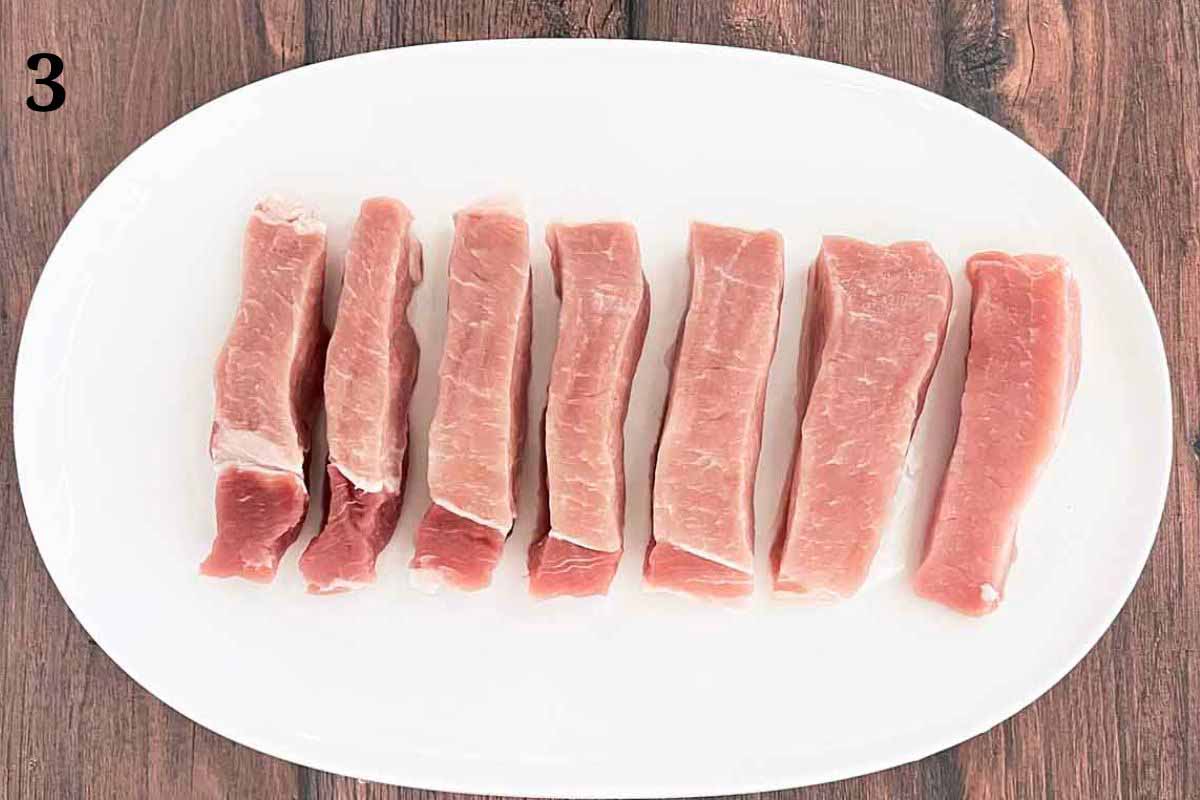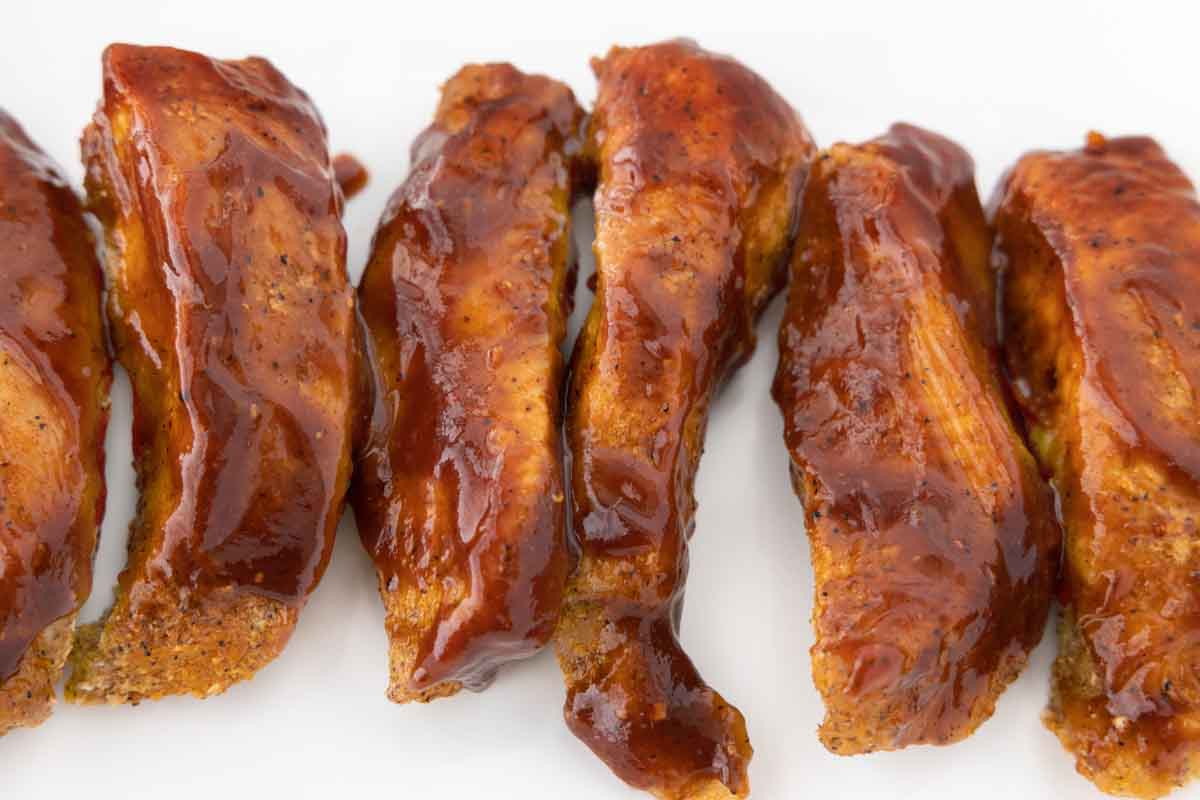Wouldn’t you love to sit down to a plateful of my tender, juicy, Smoked Country Style Ribs? Coated with a savory pork rub and finished with a tangy barbecue sauce for the perfect combination of sweet and spicy.

With just a few minutes of prep work, you’ll have my country-style ribs in the smoker, and then it’s time to let them cook low and slow until the meat is melt in your mouth tender and oh-so flavorful.
Ingredients to make smoked country-style ribs

Let’s start by gathering the ingredients we need to make smoked country style pork ribs. In Chef Speak, this is called the “Mise en Place,” which translates to “Everything in its Place.”
Not only does setting up your ingredients ahead of time speed up the cooking process, it also helps ensure you have everything you need to make the dish.
What are country-style ribs?
Well, they’re not actually ribs. Country style pork ribs come from the shoulder area of the pig. It’s a cut that is taken from the blade end of the pork loin close to the shoulder. This cut includes parts of the pork shoulder blade bone and is characterized by a good amount of marbling, which makes it tender and flavorful when cooked.
How to make smoked country-style ribs

- Add the spices for the rub to a small bowl.
- Mix well to combine seasonings.
Can I use other seasonings in my pork rub?
Yes, you can. The key to making delicious smoked ribs that you and your family will love is to use seasonings that you enjoy eating. Changing up the spices in this simple dry rub is easy and definitely something you can do each time you prepare smoked ribs, beef, pork, or chicken.
Other seasonings you could add to your spice rub are cumin, chili powder, dry oregano, ground ginger, turmeric, and coriander. You can also use your favorite seasoning blend. Cajun seasoning, jerk seasoning, barbecue seasoning, and Old Bay seasoning can be used instead of making your own dry rub.

Rub the ribs with olive oil to give the pork rub something to attach to. You can also use brown mustard or Dijon mustard as the base coat instead of olive oil. I prefer using olive oil as it doesn’t alter the taste of the pork. But if you like the taste of mustard, it will add the overall flavor.

Spread the rub generously over the country-style pork ribs making sure to season all sides of the ribs for a well-balanced flavor. If you have time, let the pork sit for 30 minutes to allow the seasonings to seep into the pork.
This also lets the meat come to room temperature before smoking.

- Preheat the smoker to 250 degrees.
- Add the wood chips of your choice to the smoker. I used pecan wood chips for these ribs.

For this recipe, I cooked the country-style ribs in a foil pan. You could place them directly on the grill grates if you like. Place the pan in the smoker and cook for 2 hours.
After 2 hours, remove the ribs from the smoker and cover the foil pan with aluminum foil and return to the smoker for an additional 1 hour or until the ribs reach an internal temperature of 195 degrees F. with a meat thermometer inserted in the thickest part of the ribs.

When the ribs reach 195 degrees F. remove them from the smoker.

Slather the ribs with your favorite brand of barbecue sauce (or my semi-homemade bbq sauce) and return them to the smoker to cook for an additional 30 minutes.
Remove the ribs from the smoker and allow them to rest for 15 minutes before serving. Serve with your favorite sides and more barbecue sauce. My coleslaw recipe and Macaroni Salad are two of my favorite side dishes.
Recipe FAQ’s
Country-style pork ribs come from the shoulder area of the pig. They’re not actually ribs but rather a cut that is taken from the blade end of the pork loin close to the shoulder. This cut includes parts of the pork shoulder blade bone and is characterized by a good amount of marbling, which makes it tender and flavorful when cooked.
Smoking the ribs at 250°F will take 3.5-4 hours. The internal temperature needs to be between 195-205 degrees for tender and juicy ribs.
Some cuts may include pieces of the pork shoulder blade bone, but there are no rib bones running through the middle of the rib.
More Recipes You’ll Love!

Smoked Country Style Ribs
Equipment
- Smoker
- Western Wood Chips
- Wireless Meat Thermometer
- Heat Resistant Gloves
Ingredients
- 3 lbs country style pork ribs
- 2 tablespoon kosher salt
- 1 tablespoon garlic powder
- 1 tablespoon onion powder
- 2 teaspoon cumin
- 2 teaspoon black pepper
- 1 teaspoon brown sugar
- 1 teaspoon paprika
- 1 cup barbecue sauce your favorite brand or my semi-homemade bbq sauce
Instructions
- Add the spices for the rub to a small bowl.
- Mix to combine seasonings.
- Rub the ribs with olive oil to give the pork rub something to attach to. You can also use brown mustard or Dijon mustard as the base coat instead of olive oil. I prefer using olive oil as it doesn’t alter the taste of the pork. But if you like the taste of mustard, it will add the overall flavor.
- Spread the rub generously over the country-style pork ribs making sure to season all sides of the ribs for a well-balanced flavor. If you have time, let the pork sit for 30 minutes to allow the seasonings to seep into the pork. This also lets the meat come to room temperature before smoking.
- Preheat Smoker to 250 degrees.
- Add the wood chips of your choice to the smoker. I used pecan wood chips for these ribs.
- For this recipe, I cooked the country-style ribs in a foil pan. You could place them directly on the grill grates if you like. Place the pan in the smoker and cook for 2 hours.
- After 2 hours, remove the ribs from the smoker and cover the foil pan with aluminum foil and return to the smoker for an additional 1 hour or until the ribs reach an internal temperature of 195 degrees F. with a meat thermometer inserted in the thickest part of the ribs.
- Carefully open the foil and slather the ribs with your favorite brand of barbecue sauce, or try my semi-homemade bbq sauce.
- Return the ribs to the smoker and cook for an additional 30 minutes.
- Remove the ribs from the smoker and allow them to rest for 10 – 15 minutes before serving.





Leave a Comment